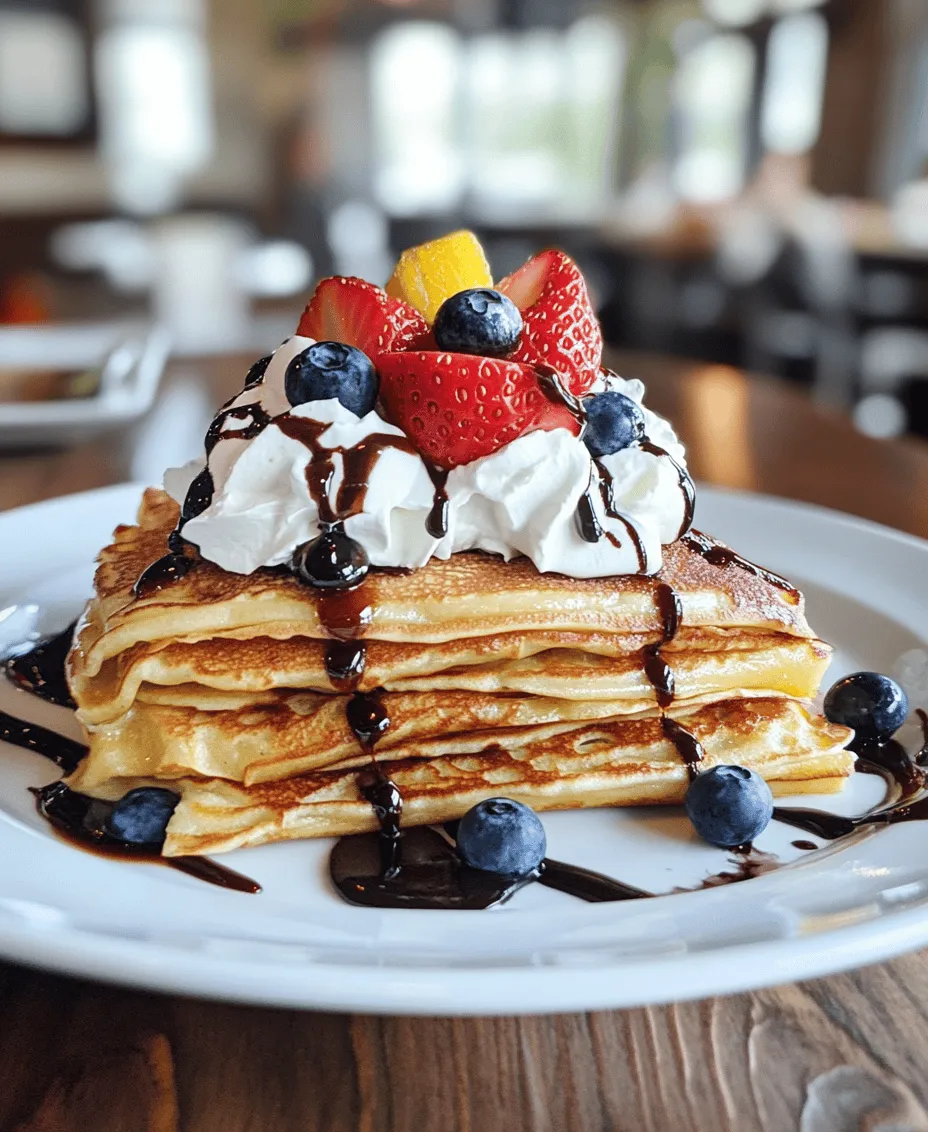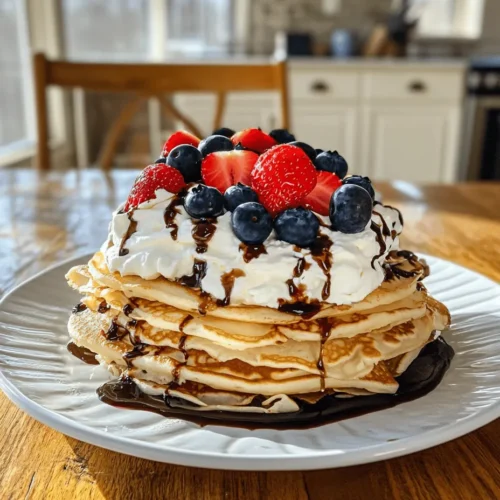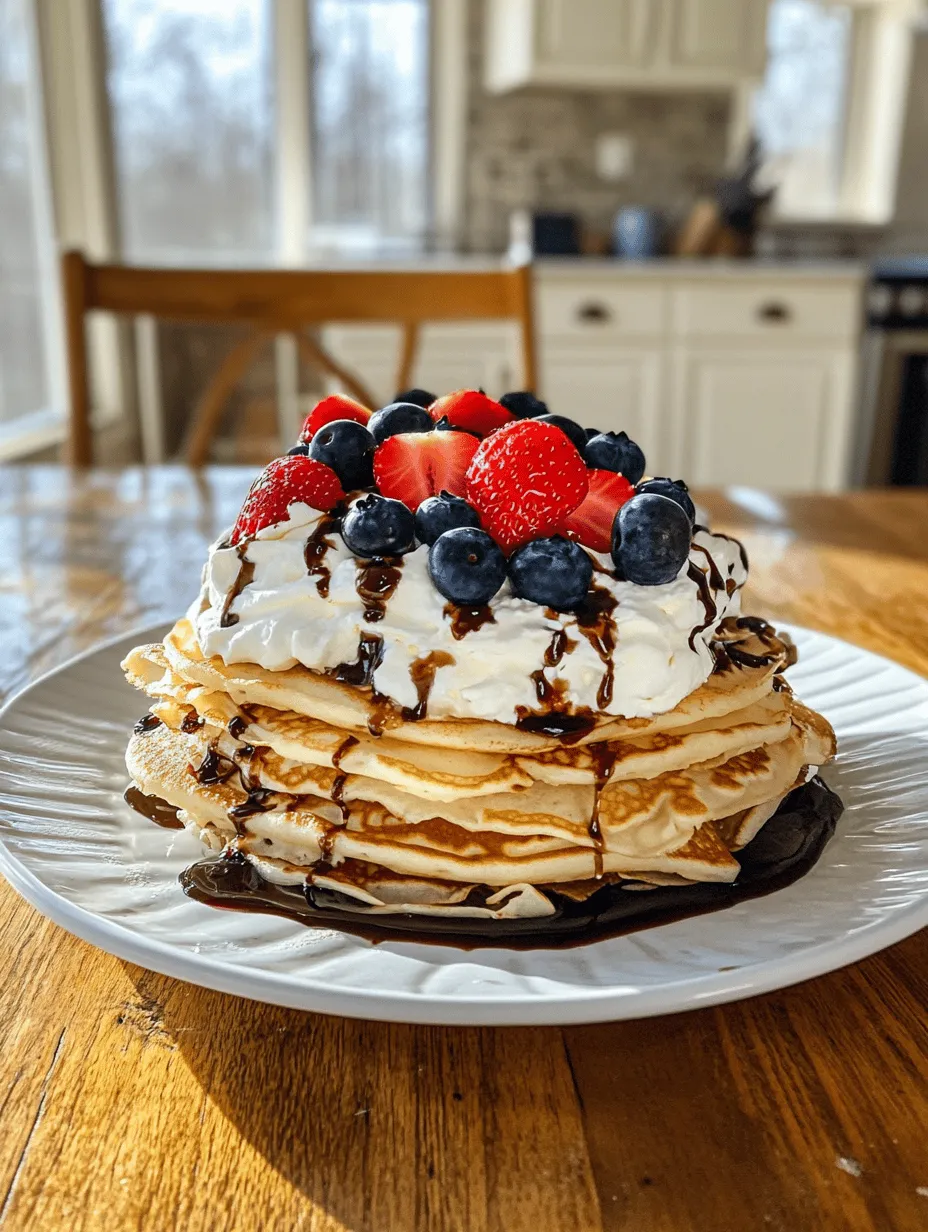Introduction
Crepes are a delightful staple enjoyed across various cultures, showcasing their versatility as both a sweet and savory dish. Originating from France, these thin pancakes have transcended borders and have become a beloved breakfast item, brunch favorite, and decadent dessert choice worldwide. The beauty of crepes lies not only in their texture and flavor but also in their adaptability; they can be filled or topped with an array of ingredients, making them suitable for any meal of the day.
While it may be tempting to opt for store-bought crepes for convenience, there is something truly special about making them from scratch. Homemade crepes allow for freshness and customization, and the process can be a rewarding culinary experience. With just a few simple ingredients, you can whip up a batch of heavenly vanilla crepes that are light, delicate, and bursting with flavor. This recipe is not only straightforward but also offers a canvas for creativity, inviting you to experiment with your favorite fillings and toppings.
In this article, we will explore the Heavenly Vanilla Crepes recipe, a perfect choice for those looking to indulge in a delicious breakfast, host a brunch gathering, or satisfy a sweet craving. With its subtly sweet flavor and airy texture, this recipe is sure to become a cherished addition to your cooking repertoire.
The Allure of Crepes
Crepes have a rich history that dates back to the 13th century in Brittany, France. Originally consumed as a simple peasant food, they were made with buckwheat flour and served in a variety of ways. Over time, crepes evolved into a staple of French cuisine, with both sweet and savory varieties taking center stage. Today, you’ll find crepes filled with an assortment of ingredients, from classic combinations like Nutella and strawberries to savory fillings like ham and cheese.
The two primary types of crepes are sweet and savory. Sweet crepes are often made with a hint of sugar in the batter and are typically served with fruits, whipped cream, chocolate sauce, or ice cream. On the other hand, savory crepes, or galettes, are usually made with buckwheat flour and can be filled with meats, cheeses, or vegetables. The versatility of crepes allows them to cater to a wide range of tastes, making them a popular dish in many households.
One of the main reasons why homemade crepes are superior to their store-bought counterparts is the ability to control the ingredients and flavors. Store-bought versions often contain preservatives and additives that can detract from the fresh taste and texture of the crepes. When you prepare them at home, you can customize the batter to suit your preferences, ensuring that every bite is as delicious as you desire. Additionally, making crepes from scratch allows for a level of freshness that is hard to match, resulting in a delightful culinary experience.
Understanding the Ingredients
To create the perfect Heavenly Vanilla Crepes, it’s essential to understand the role of each ingredient in the recipe. Here’s a breakdown of the components that contribute to the light and flavorful nature of these crepes:
All-Purpose Flour
All-purpose flour is the primary ingredient in our crepes, providing the structure and texture that is characteristic of these delicate pancakes. It is versatile and readily available, making it an ideal choice for this recipe. When combined with the other ingredients, it helps create a smooth batter that results in beautifully thin crepes.
Eggs
Eggs serve a dual purpose in this recipe. First, they act as binding agents, holding the ingredients together and providing stability to the batter. Second, they enhance the flavor and contribute to the overall richness of the crepes. The proteins in eggs also help create a tender texture, ensuring that the crepes are soft and pliable.
Milk
Milk is a vital ingredient that adds moisture and richness to the batter. It helps achieve the desired consistency, ensuring that the crepes are easy to pour and spread in the pan. The fat content in milk also contributes to the flavor, enhancing the overall taste of the crepes.
Granulated Sugar
Granulated sugar plays a key role in balancing the flavors of the crepes. While the batter is not overly sweet, the sugar enhances the overall taste and promotes browning when the crepes are cooked. This subtle sweetness pairs beautifully with a variety of toppings, making it a versatile option for both sweet and savory fillings.
Vanilla Extract
Vanilla extract is the essence of our Heavenly Vanilla Crepes. It adds a fragrant aroma and a delightful flavor that elevates the crepes from simple pancakes to a heavenly treat. The warmth of vanilla complements various toppings, making it a favorite choice for those looking to indulge in a sweet breakfast or dessert.
Melted Butter
Melted butter is another essential ingredient that contributes to the richness of the crepes. It not only enhances the flavor but also helps prevent the crepes from sticking to the pan during cooking. Using melted butter in the batter ensures that each crepe has a lovely golden-brown color and a slightly crispy edge.
Salt
Salt may seem like a minor ingredient, but it plays a crucial role in enhancing the overall flavor of the crepes. A pinch of salt balances the sweetness and brings out the natural flavors of the other ingredients, resulting in a more harmonious taste.
Optional Toppings
One of the most exciting aspects of making crepes is the endless possibilities for toppings and fillings. While the Heavenly Vanilla Crepes are delightful on their own, you can personalize them with a variety of options. Fresh fruits like berries or banana slices, dollops of whipped cream, a drizzle of chocolate or caramel sauce, or a sprinkle of powdered sugar can all elevate your crepes to new heights. For a savory twist, consider filling them with ricotta cheese and spinach, or ham and cheese for a satisfying meal. The options are limited only by your imagination.
Step-by-Step Instructions for Perfect Crepes
To achieve the most delicate and delicious Heavenly Vanilla Crepes, it’s imperative to follow a precise process when mixing the batter. Here, we will outline the steps to ensure you create a smooth and lump-free batter that will cook beautifully on the stovetop.
Step 1: Gather Your Ingredients
Before you begin, make sure you have all the necessary ingredients measured and ready to go. This will streamline the process and make it easier to focus on achieving the perfect batter. You’ll need all-purpose flour, eggs, milk, granulated sugar, vanilla extract, melted butter, and salt.
Step 2: Combine the Dry Ingredients
In a large mixing bowl, start by whisking together the all-purpose flour and granulated sugar. This ensures that the sugar is evenly distributed throughout the flour, which is essential for achieving a smooth batter.
Step 3: Add the Eggs
Next, create a well in the center of the dry mixture and crack in the eggs. Using a whisk, gently incorporate the eggs into the flour mixture, being careful not to overmix. The goal is to combine the ingredients until they are just blended.
Step 4: Gradually Add Milk
Once the eggs are incorporated, it’s time to add the milk. Gradually pour in the milk while continuously whisking. This gradual addition helps prevent lumps from forming, ensuring a smooth batter. Continue to whisk until the mixture is well combined and free of lumps.
Step 5: Incorporate Melted Butter and Vanilla
After the milk is fully integrated, add the melted butter and vanilla extract to the batter. These ingredients will enhance the flavor and richness of the crepes. Whisk until everything is combined, and the batter is smooth and creamy.
Step 6: Let the Batter Rest
For the best results, allow the batter to rest for at least 30 minutes. This resting period allows the gluten in the flour to relax, making it easier to create thin, delicate crepes. It also helps the flavors meld together, resulting in a more cohesive taste.
Step 7: Prepare Your Cooking Surface
While the batter is resting, prepare your cooking surface. Preheat a non-stick skillet or crepe pan over medium heat. If desired, lightly grease the pan with a small amount of melted butter to ensure the crepes do not stick.
As you embark on your journey to create these heavenly vanilla crepes, the anticipation builds with each step. From the mixing of the batter to the tantalizing aroma that fills your kitchen as they cook, this recipe promises to deliver a delightful experience that will leave you craving more. Stay tuned for the next section, where we’ll delve into the cooking process and perfecting your crepes!

Importance of Resting the Batter
Resting the batter is a crucial step in making heavenly vanilla crepes. When you allow the batter to sit for at least 30 minutes (or even up to two hours), it gives the flour time to hydrate fully. This hydration process helps to develop gluten, which contributes to the texture of the crepes. A rested batter results in a smoother, more cohesive mixture that will yield tender, pliable crepes when cooked. Additionally, resting allows any air bubbles formed during mixing to dissipate, leading to fewer imperfections and an overall better outcome. If you’re in a hurry, even a brief 15-minute rest is better than no rest at all, but planning ahead will guarantee the best results.
Tips for Heating the Pan
Achieving the ideal temperature for cooking crepes is essential for perfecting their texture. The pan should be preheated before you pour in the batter. A non-stick skillet or crepe pan is the best choice for even cooking. To check if your pan is ready, conduct the “water droplet test”: sprinkle a few drops of water onto the surface. If they sizzle and evaporate almost immediately, your pan is at the right temperature. If the water simply sits there, it means the pan is not hot enough; if it evaporates too quickly, it may be too hot. A temperature around medium to medium-high heat is ideal. Adjust the heat as needed during cooking, as the pan’s temperature can fluctuate.
Technique for Pouring and Cooking Crepes
Pouring the batter correctly is a key technique that will affect the thickness and even distribution of your crepes. Start by holding the pan at a slight angle to help the batter spread evenly. Pour about 1/4 cup of batter into the center of the pan. Quickly tilt the pan in a circular motion to spread the batter out into a thin layer. The goal is to achieve a crepe that’s about 1/8 inch thick. If the batter is too thick, your crepes will be dense; if too thin, they may fall apart. Cook the crepe for about 1-2 minutes until the edges begin to lift and the surface appears set before flipping.
Flipping Crepes: Tips for Mastering the Technique
Flipping crepes can be intimidating, but with practice, it becomes second nature. Once the edges of the crepe are set and a light golden color develops, it’s time to flip. Use a spatula to gently lift one edge of the crepe, sliding it under the entire crepe. Once you have a good grip, quickly but gently flip it over. You can also use your hands to flip the crepe if you feel confident, but be cautious not to burn yourself. Cook the second side for an additional 30 seconds to 1 minute until it is lightly golden. Practicing will help you master this skill, and soon you’ll be flipping crepes like a pro!
Keeping Cooked Crepes Warm
Once your crepes are cooked, it’s important to keep them warm and pliable while you finish cooking the rest. To do this, simply stack the cooked crepes on a plate and cover them with a clean kitchen towel. This will help retain moisture and prevent them from drying out. Alternatively, you can place the plate in a warm oven set to the lowest temperature (about 200°F or 90°C) to keep them warm without cooking them further. Avoid stacking them too tightly, as this can make them soggy.
Serving Suggestions
Presentation is key when serving your heavenly vanilla crepes. Start by stacking two or three crepes on a plate, slightly overlapped for an elegant look. You can also fold them into quarters or roll them up for a more casual presentation. Drizzle your chosen toppings over the crepes for a beautiful finish.
Creative Topping Combinations
1. Fresh Fruit Options: Top your crepes with a medley of fresh berries like strawberries, blueberries, or raspberries. Sliced bananas or citrus segments, such as oranges or grapefruits, also add a refreshing burst of flavor. Consider macerating the fruit in a bit of sugar and lemon juice for an extra delightful taste.
2. Sweet Toppings: Whipped cream is a classic choice that pairs perfectly with the lightness of the crepes. For a more decadent option, drizzle chocolate sauce or caramel over the top. Maple syrup is another delightful sweetener that enhances the flavor profile beautifully.
3. Savory Variations: If you wish to explore savory options, consider filling your crepes with sautéed mushrooms, spinach, and cheese for a hearty dish. A combination of ricotta and herbs can also make for a delicious stuffing. These savory variations allow the versatility of the crepe recipe to shine through, making it suitable for any meal of the day.
Nutritional Insights
Understanding the nutritional composition of your crepes can help you enjoy them guilt-free. A basic crepe made from flour, eggs, milk, and butter typically contains around 100 calories per crepe, depending on the size and additional ingredients used. These calories mainly come from carbohydrates and fats, providing a quick source of energy.
When it comes to portion sizes, consider that two to three crepes per serving, depending on the fillings and toppings, can be satisfying. Homemade crepes are often healthier than store-bought varieties, as you can control the ingredients and avoid preservatives. Additionally, making them from scratch allows you to adjust the recipe to cater to dietary considerations, such as using whole wheat flour or non-dairy milk for a healthier alternative.
Homemade crepes also offer health benefits by allowing you to include nutrient-dense fillings, such as fruits and nuts, which provide vitamins, minerals, and fiber that are often lacking in pre-packaged options.
Common Mistakes to Avoid
Even seasoned cooks can encounter issues when making crepes. Here are some common mistakes to avoid:
1. Incorrect Batter Consistency: If your batter is too thick, it will produce dense crepes. If it’s too thin, the crepes may tear easily. Aim for a consistency similar to heavy cream, adjusting with a little more milk or flour as necessary.
2. Cooking Temperature: One of the most frequent errors is cooking crepes at too high or too low a temperature. Too high can lead to burnt crepes, while too low will result in rubbery textures. Maintain a steady medium to medium-high heat for optimal results.
3. Forgetting to Rest the Batter: Skipping the resting period can lead to uneven texture and toughness. Always give your batter at least 30 minutes to rest.
4. Overcrowding the Pan: When cooking multiple crepes, avoid overcrowding the pan. This can lead to uneven cooking and makes it difficult to flip the crepes properly. Cook one or two at a time for the best results.
Conclusion
Making heavenly vanilla crepes at home is not only a delightful culinary adventure but also a chance to create and share wonderful memories with loved ones. The joy of flipping delicate crepes and customizing them with your favorite toppings is a rewarding experience that transcends simple cooking. Whether you choose to fill them with fresh fruits, indulgent sauces, or savory delights, the possibilities are endless.
As you experiment with different flavors and presentations, remember that each batch of crepes is a blank canvas, ready to be transformed into something unique and delicious. Embrace the versatility of this classic dish and enjoy the satisfaction of creating something special from scratch. We encourage you to gather your ingredients, invite friends or family into the kitchen, and celebrate the simple pleasure of cooking and sharing food. Your journey toward mastering heavenly vanilla crepes is just beginning, and the possibilities are as limitless as your imagination. Happy cooking!



